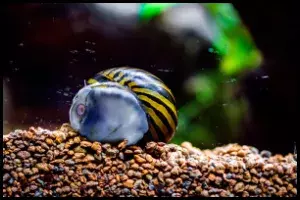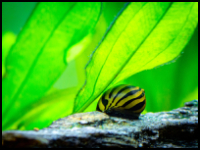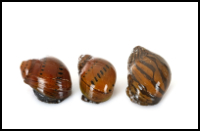





Quick Care Details (Table)
| Livestock Characteristics | Value |
|---|---|
| Care Level | Easy |
| Temperament | Peaceful |
| Diet | Omnivore |
| Maximum Size | 1 Inches |
| Minimum Tank Size | 5 Gallons |
| Plant Safe | Yes |
| Temperature Range | 65-85F |
| PH Range | 6.5-8.0 |
| KH Range | 5-12 |
Species Specific Categories
Helpful Video
Care Details
Aquascape: Zebra Nerite Snails, those charming little algae-eaters, can be a lovely touch to your freshwater aquarium. When setting up their aquatic abode, think about their size and delicacy. Choose decor and plants with smooth, rounded edges to prevent any shell damage.
Substrate: While these snails don't fuss much about substrate type, a sandy or fine gravel bottom mimics their natural habitat and offers an excellent surface for them to scour for tasty morsels.
Disease Prevention: The good news is that Zebra Nerite Snails are quite hardy and resistant to most diseases. Your main task is to keep their water clean and temperature stable, which is a win-win for your whole tank.
Filtration: Clean water is crucial, and an efficient filter is your best friend. Canister or sponge filters are great choices. Just keep an eye on water flow; these snails don't appreciate waterpark-level currents.
Lighting: They're not picky about lighting, so moderate illumination is fine. A consistent day-night cycle will keep both your snails and aquatic plants happy.
Water Flow: Speaking of water, Zebra Nerite Snails prefer a gentle current. Double-check your filter's settings to avoid turning their home into a water slide.
Hardiness: These snails are troopers. They can handle various water conditions, but, like any aquarium critter, they thrive when life in the tank is stable and well-tended.
Acclimation: When bringing these beauties home, take your time acclimating them. Float their container in your tank to match the temperature and then give them a gracious welcome.
Expected Lifespan: In the grand scheme of aquarium life, Zebra Nerite Snails are the marathon runners, typically living for 2 to 3 years or even more if their needs are met.
Special Requirements: To keep those zebra-striped shells gleaming, these snails need a calcium source. That means a diet rich in algae or the occasional calcium supplement treat.
document.getElementById("care-details-next-tab").addEventListener("click", function() {
document.getElementById("temperament-tab").click();
});
Temperament and Behavior
Behavior: Zebra Nerite Snails are the diligent janitors of the aquarium world. They spend their days leisurely gliding across surfaces, often seen feasting on algae. While they may not win any aquatic races, their slow and steady pace makes them excellent algae eaters and peaceful tank companions.
Breeding: Breeding Zebra Nerite Snails in captivity can be a bit of a mystery. They typically lay eggs on hard surfaces, but these eggs rarely hatch in freshwater tanks. You'd need a brackish or saltwater environment to have any chance of raising their offspring.
Aggression: When it comes to aggression, Zebra Nerite Snails are the peacekeepers of the tank. They are as non-aggressive as it gets, and you can safely keep them with a variety of freshwater snails and other tankmates.
Tankmates Compatibility: Zebra Nerite Snails are the ultimate team players. They coexist harmoniously with other peaceful fish, shrimp, and snails. Just ensure your tank doesn't house any known snail-eating predators.
Activity Level: These snails are on a slow-motion adventure most of the time. Their leisurely pace and algae-munching habits make them a calming presence in the aquarium.
Schooling or Shoaling Behavior: Zebra Nerite Snails are not schoolers or shoalers. They prefer solo adventures, grazing independently on algae and biofilm.
Plant Compatibility: If you're a fan of aquatic plants, you'll love Zebra Nerite Snails. They won't nibble on your lush greenery, making them ideal for planted tanks. In fact, they can help keep your plants clean by munching on algae growth.
Coral Reef Compatibility: Picture Zebra Nerite Snails as the diligent custodians of your coral reef aquarium. They're like the tidy butlers who discreetly clean up without causing any trouble. These snails are well-suited for coral reef environments because they're primarily algae-eaters and won't harm your precious coral.
document.getElementById("temperament-next-tab").addEventListener("click", function() {
document.getElementById("diet-tab").click();
});
document.getElementById("temperament-previous-tab").addEventListener("click", function() {
document.getElementById("care-details-tab").click();
});
Diet and Nutrition
Dry Foods: Zebra Nerite Snails are like the die-hard vegans of the aquatic world. They're not particularly interested in traditional fish flakes or pellets. Instead, they have a strong preference for plant-based diets, such as algae wafers or spirulina tablets. These dry foods provide them with the nutrients they need.
Frozen Foods: Zebra Nerite Snails aren't into frozen cuisine. They won't bother with frozen brine shrimp or bloodworms. Stick to their beloved plant-based options.
Live Foods: Like someone who appreciates a fresh, farm-to-table meal, Zebra Nerite Snails prefer live algae and biofilm as their natural, go-to food source. This mirrors their diet in the wild, so it's best to maintain a well-established aquarium with natural algae growth to keep them happily fed.
Vegetables: These snails are the herbivores of the aquarium world. Offer them blanched vegetables like zucchini, spinach, or cucumber as an occasional treat. They'll nibble on these with pleasure.
Algae: Algae are the staple of their diet. Zebra Nerite Snails are the algae-eating enthusiasts you want in your tank. They'll tirelessly graze on algae, keeping your aquarium glass and decorations clean.
Feeding Schedule: Zebra Nerite Snails are the slow and steady eaters. You won't find them frantically darting for food. They graze consistently throughout the day, keeping their bellies full. Offer their plant-based options regularly to ensure they have access to food.
Supplemental Foods: In addition to their beloved algae wafers and live algae, you can occasionally provide blanched veggies. Just remember, moderation is key, as they mainly thrive on algae.
document.getElementById("diet-previous-tab").addEventListener("click", function() {
document.getElementById("temperament-tab").click();
});
document.getElementById("diet-next-tab").addEventListener("click", function() {
document.getElementById("tank-parameters-tab").click();
});
Tank Parameters
Tank Size: Think of Zebra Nerite Snails as the cozy apartment dwellers of the aquarium world. They don't need a massive space. A small to medium-sized tank will suit them just fine. A 10-gallon tank is ideal for a small group of these snails.
Tank Length and Measurements: When setting up their aquatic home, consider providing ample horizontal space. They don't require towering heights; instead, focus on creating a comfortable, wide area for them to explore.
Species Maximum Size: Picture Zebra Nerite Snails as the compact cars in the aquarium lineup. They reach a maximum size of around one inch (2.5 cm). They won't outgrow their welcome, making them perfect for smaller setups.
Water Temperature: Zebra Nerite Snails appreciate a cozy, tropical environment. Maintain a water temperature between 72°F to 78°F (22°C to 26°C). This range ensures they stay comfortable and active.
pH (Acidity/Alkalinity): These snails prefer stable water conditions. Aim for a neutral pH level around 7.0 to 7.5. They'll thrive in this balanced environment.
Nitrate (NO3) Levels: Zebra Nerite Snails are like water quality inspectors. They're sensitive to nitrate levels, so it's essential to keep nitrate concentrations low, ideally below 20 ppm. Regular water changes will help maintain a healthy environment for them.
Salinity: Unlike their marine counterparts, Zebra Nerite Snails are freshwater aficionados. They thrive in freshwater aquariums, so there's no need to fuss about salinity levels. They also can thrive in Brackish or Saltwater/Marine environments you just need to make sure you acclimate them correctly.
Phosphate (PO4): Keep phosphate levels in check to prevent excess algae growth, which is their main food source. Aim for a range of 0.2 to 0.5 ppm.
Alkalinity (dKH): Zebra Nerite Snails don't require particularly high alkalinity levels. A range of 6 to 12 dKH should suffice to maintain stable water conditions.
document.getElementById("tank-parameters-previous-tab").addEventListener("click", function() {
document.getElementById("diet-tab").click();
});
History, Popularity, History and Species Variety Details
History: Zebra Nerite Snails, known for their distinctive black and gold-striped shells, have an intriguing backstory. These snails hail from the waters of Southeast Asia, specifically Indonesia, the Philippines, and the Malayan peninsula. They've been part of the aquarium scene for a while, prized both for their mesmerizing appearance and their knack for keeping tanks free from algae.
Popularity: Think of Zebra Nerite Snails as the rock stars of the aquatic pet world. Their popularity has surged in recent years, and it's easy to see why. With their eye-catching stripes and excellent algae-eating skills, they've become a must-have addition for many aquarium enthusiasts. People adore them not only for their looks but also for their ability to maintain clean and clear tanks.
Natural Habitat: Picture these snails in the serene, slow-moving waters of their native lands. They cling to rocks, driftwood, and aquatic plants, diligently grazing on the algae and biofilm that naturally grow in these environments. Their adaptability to a range of water conditions, from slightly brackish to freshwater, showcases their resilience and ability to thrive.
So, there you have it – the intriguing history, growing popularity, and the natural habitat of the Zebra Nerite Snail, making them a fascinating and cherished addition to aquariums worldwide.
Varients of the zebra nerite snail
- Tiger Nerite Snail: These snails are like the artistic cousins of Zebra Nerites. Instead of stripes, they have intricate zigzags on their shells in shades of brown and black. Tiger Nerites are just as skilled at chowing down on algae and are often chosen for their unique shell patterns.
- Olive Nerite Snail: Imagine snails with olive-green shells. Olive Nerites are your go-to crew for algae control. They're super low-maintenance and work wonders in freshwater and slightly brackish tanks.
- Horned Nerite Snail: The name comes from their pointy shells. These snails can have various shell colors, including dark brown, black, and reddish-brown. They're great at keeping algae at bay and fit well in freshwater and slightly brackish aquariums.
- Sun Thorn Nerite: If you want a burst of color, check out the Sun Thorn Nerite. Their shells range from yellow to orange, and they sport little spikes. These snails love to graze on algae and can thrive in freshwater or brackish setups.
- Red Spotted Nerite Snail: As the name suggests, these snails have eye-catching red spots on their shells. They're algae-eating machines and thrive in freshwater tanks. If you want a pop of color and effective algae control, these snails are a fantastic choice.
- Tire Track Nerite Snail: Known for the unique pattern on their shells resembling tire tracks, these snails are both stylish and functional. They keep your tank free from algae and are happy residents of freshwater or brackish environments.
- Black Racer Nerite Snail: These snails are like the stealthy racers of the Nerite world. Their smooth, dark shells add a touch of elegance to your tank, and they're diligent algae eaters. Like their cousins, they prefer freshwater or slightly brackish conditions.
- Panda Nerite Snail: If you're into adorable aquatic creatures, Panda Nerites might steal your heart. Their tiny, panda-like spots on a yellowish background make them look like little pandas in snail form. They're excellent at algae control and can be comfortably placed in freshwater tanks.
Personal Perspective
I find them to be one of the best freshwater snails you could get! These guys won't become a population control type pest for your aquarium since they don't breed in freshwater.
They have super cool shells and actually come in several shell patterns. They aggressively eat algae, and I find that they even are able to eat the all-feared black beard algae. Now, to be specific, they will eat some of the weaker blackbeards, but if you have an aggressive blackbeard problem, they probably won't be able to solve it for you.
I would also invest in a magnet glass scrapper. It's not for the algae since the snail will get it, but you can use it to scrap their eggs off the glass. It is a little unsightly, and there is no point in leaving them since they will never hatch.
Frequently Asked Questions
Can they escape from the tank?
Zebra Nerite Snails are not known for climbing out of tanks, so you don't need to worry about them exploring your living room.
Do I need to supplement their diet?
While they primarily feed on algae, it's a good idea to offer supplemental foods like algae wafers or blanched vegetables to ensure they get a balanced diet. You might also want to consider calcium-type supplements to encourage proper shell growth.
Any special care tips?
Maintain stable water conditions, ensure good water quality, and provide a variety of algae-based foods to keep your Zebra Nerite Snails happy and healthy.
What's their lifespan?
Zebra Nerite Snails typically live for about one to two years, but with proper care, they can enjoy a longer life in your aquarium.
Can they live with other fish and snails?
Yes, they are peaceful tankmates and get along well with most fish and other snail species. They won't harm your plants either.
How effective are they at algae control?
Zebra Nerites are top-notch algae eaters. They'll munch on common types of algae, such as diatoms and soft green algae, keeping your tank glass and decorations clean.
Do they breed easily?
Zebra Nerite Snails lay eggs, but their eggs require brackish water to hatch, so they won't overpopulate your tank with snail babies.
Are Zebra Nerites suitable for small tanks?
Absolutely. These snails are on the smaller side, making them perfect for small to medium-sized aquariums. They won't overcrowd your tank.
What kind of tank do they prefer?
Zebra Nerite Snails thrive in freshwater or slightly brackish water tanks. They are a great choice for both beginners and experienced hobbyists.
What's so special about Zebra Nerite Snails?
Zebra Nerite Snails are popular for their striking black and gold striped shells. They're not only visually appealing but also excellent algae eaters, helping to keep your tank clean.

